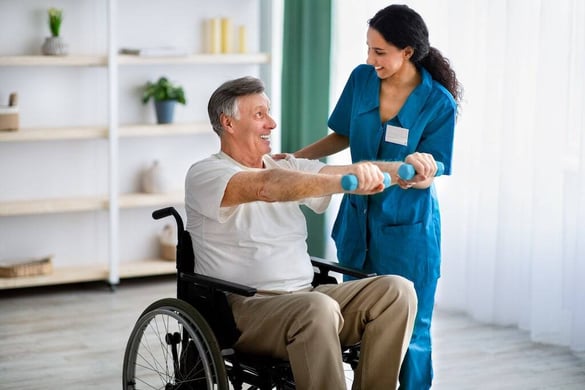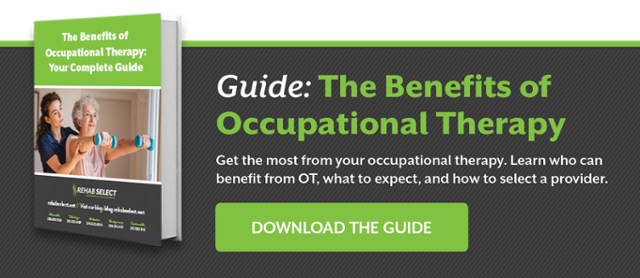
You may be at home alone when it strikes. Suddenly, the left of side of body becomes completely numb… followed by the right side. You fall over and wake up at the hospital. You’ve just experienced a stroke and your life has changed---at least for the time being.
A stroke occurs when the blood flow to your brain is interrupted by a blood clot or a blood vessel that bursts. Strokes prevent oxygen and nutrients from reaching the brain, causing brain cells to die almost immediately. When this happens, the effects can be debilitating.
After a stroke, a patient may become paralyzed on one side or both sides of the body. They may struggle with speech and language problems. The patient may have trouble with vision. They may have varying degrees of memory loss. These effects often leave them unable to care for themselves, socialize, work, and participate in the community.
Stroke is one of the most common causes of disability in the United States. There are 7 million stroke survivors in the U.S. and 795,000 cases of stroke each year. Although a stroke can be devastating, there’s hope for recovery. Stroke patients can be rehabilitated with the help of a multidisciplinary team. According to the American Stroke Association, 10 percent of stroke survivors recover nearly completely, while another 25% recover with minor impairments.
8 Benefits of Occupational Therapy
Occupational therapy is an important part of a multidisciplinary approach to stroke rehab. The American Occupational Therapy Association states that stroke patients who receive occupational therapy are “significantly less likely to deteriorate and more likely to be independent in their ability to perform activities of daily living and the end of treatment.”
The stroke rehab team may include a physiatrist, neurologist, physical therapist, rehabilitation nurse, speech-language pathologist, social worker, psychologist, case manager, and occupational therapist. Stroke rehabilitation (including occupational therapy) takes place in the rehabilitation or subacute care unit of hospitals, at home, in outpatient services, or in a long-term care facility.
Throughout treatment, the occupational therapist will focus on helping the patient regain the ability to live independently, resume normal levels of activity. Occupational therapists evaluate their patients as a whole person as well as their environment to develop strategies that will help them do the things they need and want to do. As the stroke patient gradually learns new skills that enable them to live more fully and independently, they will also gain more hope, optimism, motivation and self-confidence.
For stroke patients, the benefits of occupational therapy are the following:
Self-Care Skills
It may be difficult for the stroke patient to carry out many of the normal self-care activities because of the effects of the stroke. Bathing, grooming, and dressing may all have become difficult or near impossible without learning new ways of doing them. Occupational therapists can teach stroke patients strategies for self-care as well as introduce adaptive equipment and changes to their environment to make these tasks more manageable.
Home Safety
After a stroke, patients may need to change how their home is laid out to create a safer environment or to make it easier to accomplish takes with some impairments. Occupational therapists often will evaluate how patients perform daily activities, such as rising from bed, getting dressed, cooking, showering, etc. within the home to make recommendations or adjustments.
Strength and Endurance
After a stroke, a patient may experience weakness on one side of the body or both sides. Stroke rehab exercises can be an important way to regain strength and freedom of movement. The occupational therapist can create a program of exercises combined with normal activities (for example, cooking or doing laundry) that will help the patient improve their strength, agility and endurance.
Cognition
Stroke patients will likely have cognitive problems such as impairments in memory and concentration, leading to difficulty carrying out many daily activities. Occupational therapists can not only plan a program of stroke rehab exercises to improve cognition, but also help come up with practical strategies to work around limitations. The patient might try breaking up activities into more manageable parts, use daily planners, and rely on other compensatory strategies.
Community Reintegration
Stroke patients may have trouble integrating back into society with impairments such as paralysis, vision problems, and memory problems. It may be difficult to engage with people and the environment at work, school, or even the bank or grocery store. Occupational therapists can help stroke patients relearn how to do many of these activities or use compensatory strategies in real-life settings.
Work and School
Occupational therapists can evaluate work sites and work responsibilities and collaborate with employers and the stroke patient to plan a safe and successful return to work. The occupational therapist assesses what the stroke patient is capable of in to make recommendations and come up with modifications that will help the patient succeed. Occupational therapists can also work with educational institutions to coordinate a return to school.
Healthy Lifestyle
Whether it’s eating better, being more active, smoking less, managing blood pressure and cholesterol or staying positive and sustaining mental health and wellness, stroke patients can change their lifestyle in many ways that will help prevent a second stroke. An occupational therapist can help create this plan, teach supporting strategies, monitor progress, and help the patient stay motivated to achieve these goals.
Motivation and Confidence
Stroke patients may feel discouraged at times because of the sudden change in lifestyle that often follows a stroke and recognition of obstacles ahead. Yet motivation is one of the key factors that determines the success of rehabilitation. Stroke patients need plenty of motivation to take part in the stroke rehab exercises that will help them function better in daily life. Occupational therapists can provide psychological support and help their patients set goals during rehab.
Are you ready to enlist the help of an occupational therapist or stroke rehab team to get your life back after a stroke? Learn more about occupational therapy at Rehab Select by scheduling a tour.




